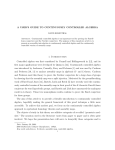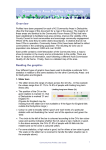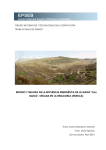Download User manual for London Heat Map
Transcript
User manual for London Heat Map 1 Introduction The London Heat Map website comprises five groups of layers containing 1. Administrative geography and rivers (“London Geography”) 2. Information relevant to planning district heating systems (“DH masterplanning layers”) 3. Ordnance Survey maps (“Ordnance Survey”) 4. Information relevant to the identification of areas of London suited/likely to benefit from district heating (“Policy indicators”) 5. A set of layers showing the input data used to generate the layers in (4) above. (“Base layers”) These layer groups are described briefly in Section 2 below. Section 3 gives more detailed information on each of the individual map layers on the London Heat Map site. Layers can be switched on and off using the tick-boxes in the Map Contents panel to the left of the map window. Layers with a (+) after the name are folders containing sub-layers and/or sub-folders. Note that the vertical ordering of the layers cannot be altered, and has designed to optimise the visual experience of using the map tool. It does not denote any relative importance of the layers Note that the London Heat Map is an interactive tool, with users invited to upload energy information on potential anchor loads for decentralised energy schemes, heat supply plant and networks. We will update this user manual accordingly as the map becomes further populated with energy information. 2 Summary of map layer contents 1. London Geography Contains layers showing the GLA and Borough boundaries, and London’s rivers and reservoirs. 2. DH masterplanning layers This folder contains a number of layers intended for use in identifying specific areas and sites most suited to connection to heat distribution systems. These include: • • new development areas, represented by the Opportunity Area Planning Framework layer. new development sites, represented by London Development Database records • • • showing the location/shape of all sites receiving planning permission for large development in London since 2004. Potential anchor heat loads for district heating systems, covering a wide range of building types. Potential heat supply locations, currently covering sites participating in the European Emissions Trading System (EUETS), CHP sites, energy from waste plant, and other low or zero carbon plants Existing and proposed district heating networks 3. Ordnance Survey The Ordnance Survey (OS) folder contains three layers (although there are five objects in the folder). These are: • • • London Addresses, which shows the location of all the city’s addresses, based on the OS Addresspoint dataset, split into residential and non-residential addresses. OS Mastermap Topography shows the outlines of buildings, roads, tracks and paths, railways, water features, other structures, and administrative boundaries. This layer only becomes visible when the user zooms into a map scale of 1:5000 or greater. OS Rasters, which are backdrop maps of London streets and buildings. The map automatically selects the most appropriate raster scale for the current zoom level. 4. Policy Indicators This folder contains layers intended to assist policymakers and masterplanners in identifying areas of London within which district heating is likely to be most viable (for example in terms of spatial densities of heat demand), and where it may serve to reduce fuel poverty through the provision of low-cost, low-carbon heat. The policy indicators folder contains contour maps which show how the values mapped vary across London. The following information is provided: Match between residential and commercial heat consumption, which is likely to lead to complementary heat load profiles, and hence improved district heating economics • Density of social housing. Social housing is an important indicator of the potential for new district heating projects connecting existing heat loads. Social housing offers relatively high heat demand per connected building and social housing providers can bring a large volume of heat demand under a single contract. • Fuel poverty risk. District heat (ideally from combined heat and power generation) is one of the only low-carbon energy supply technologies that can reduce end-user fuel costs. As a result it has the potential to address climate change and fuel poverty simultaneously. • Heat demand density. When specific heat distribution routes have not yet been defined, the best way of identifying areas of sufficiently high heat demand to support district heating is to map the spatial density of heat demand – that is, the total amount of heat consumed annually per unit area (e.g. kWh/m2 per year). The layers in this folder show annual consumption in kWh, per square metre of land area. The ‘fixed scale’ layer allows the user to select the level of granularity in the heat density contour map, while the auto-scale layer selects the most appropriate view for the current map scale. 5. Base layers This folder contains a set of layers showing the inputs to the policy indicators shown in (4) above. These are: • Fuel Poverty Indicator: This show the Fuel Poverty Indicator (FPI) (2003) produced by the Centre for Sustainable Energy and the University of Bristol. The FPI models the risk of fuel poverty in each census output area in England. This layer shown here maps the proportion of households in each output area predicted to be in fuel poverty (the FPI shown here is the full equivalised income definition: see www.fuelpovertindicator.org.uk for more information). This data was used to produce the fuel poverty contour map shown in the policy indicator folder. • Social housing: This layer shows the total number of social-rented dwellings in each census output area, and is taken directly from the 2001 Census. The contour version of this data shows dwelling per hectare, based on the area of each census output area. • Economy 7 Heating: This layer is included because switching electrically heated buildings to district heating can generate significant carbon savings and fuel cost reductions. However the retrofitting costs are high, since the existing heating systems have to be replaced in every dwelling to be connected to district heating. • Grid maps showing total heating fuel demand: these layers shows the spatially modelled annual heating fuel consumption at a range of grid resolutions, from 50m x 50m (the resolution at which the modelling was performed) up to 1km x 1km. There are two versions of this layer: the first automatically adjusts the grid square size based on the current map scale, and the second allows the user to select the desired grid resolution independently. 3 Detailed information on map layers Layer Group 1: London Geography Layer Source Date Notes Layer Source Date Notes Layer Source Date Notes Layer Source Date Notes Layer Source Date Notes 1. London Geography\1.1 Boundaries\ 1.1.1 GLA Boundary OS Boundary Line 2008 Ordnance Survey administrative boundary for the Greater London Authority Area 1. London Geography\1.1 Boundaries\ 1.1.2 GLA Mask Generated from Os Boundary Line 2008 Clips the map display to the Greater London boundary 1. London Geography\1.1 Boundaries\ 1.1.3 Borough Boundaries OS Boundary Line 2008 Ordnance Survey administrative boundary for the London Boroughs and City of London 1. London Geography\1.2 Water\ 1.2.1 River Thames Greater London Authority (GLA) 2009 Shows the River Thames and tributaries 1. London Geography\1.2 Water\ 1.2.2 Other GLA 2009 Shows lakes and reservoirs Layer Gropup 2: DH Masterplanning 2.1.1 New Development Source Date Notes 2. DH Masterplanning\ 2.1 Major Heat Loads\ 2.1.1 New Development\ LDD (2004 onwards) - points London Development Database, GLA 2009 Shows the point locations of all planning permissions granted in London since 2004, where these were at least 150 residential units or 15,000 square metres of non-residential floorspace. Layer 2 Layer Source Date Notes DH Masterplanning\ 2.1 Major Heat Loads\ 2.1.1 New Development\ LDD (2004 onwards) - polygons London Development Database, GLA 2009 Shows the site boundaries of some of the largest planning permissions granted in London since 2004, Where atleast 150 residential units or 15,000 square metres of non-residential floorspace. Layer Source Date Notes 2 DH Masterplanning\ 2.1 Major Heat Loads\ 2.1.1 New Development\ OAPF GLA 2008 Opportunity Areas are identified in the London Plan as areas for significant growth in housing and employment. As set out in the draft replacement London Plan (published 12 October 2009), the Mayor will provide proactive encouragement, support and leadership for partnerships preparing and implementing Opportunity Area Planning Frameworks to realize their growth potential. 2.1.2 Potential Anchor Heat Loads Layer Source Date Notes 2 DH Masterplanning\ 2.1 Major Heat Loads\ 2.1.2 Potential Anchor Heat Loads\ Multi-address buildings (>49 per building) Calculated from OS Address-point 2008 Shows locations of buildings containing at least 50 separate addresses. Split into residential and non-residential sub layers, each of which contains a further two layers, to allow reformat depending on zoom level. At smaller map scales, buildings are displayed as a simple point. At larger scales, they are displayed as circles, the sizes of which are proportional to the number of addresses. Included because of potentially high heat demand per district heating connection. Date Notes DH Masterplanning\ 2.1 Major Heat Loads\ 2.1.2 Potential Anchor Heat Loads\ Sport & Leisure Facilities Combination of data identified from OS Address-point and data supplied by the GLA 2008 Shows locations of gymnasiums, sports halls, leisure centres and swimming pools. Layer 2 Layer Source 2 Date Notes DH Masterplanning\ 2.1 Major Heat Loads\ 2.1.2 Potential Anchor Heat Loads\ Prisons Combination of data identified from OS Address-point and data supplied by the GLA 2008 Shows locations of London’s prisons Layer 2 Source Source Date Notes DH Masterplanning\ 2.1 Major Heat Loads\ 2.1.2 Potential Anchor Heat Loads\ Hotels Identified from OS Address-point 2008 Shows locations of hotels Layer 2 Source Date Notes Layer Source Date Notes DH Masterplanning\ 2.1 Major Heat Loads\ 2.1.2 Potential Anchor Heat Loads\ Educational Facilities Identified from OS Address-point 2008 Shows locations of schools and higher education facilities in two separate sublayers 2 DH Masterplanning\ 2.1 Major Heat Loads\ 2.1.2 Potential Anchor Heat Loads\ Police Stations Identified from OS Address-point 2008 Shows locations of police stations. Many of these will be in use 24 hours a day, and can benefit district heating systems by improving load diversity Layer Source Date Notes 2 DH Masterplanning\ 2.1 Major Heat Loads\ 2.1.2 Potential Anchor Heat Loads\ Fire Stations Identified from OS Address-point 2008 Shows locations of fire stations. Many of these will be in use 24 hours a day, and when connected can benefit district heating systems by improving load diversity Source Date Notes DH Masterplanning\ 2.1 Major Heat Loads\ 2.1.2 Potential Anchor Heat Loads\ NHS Identified from OS Address-point 2008 Shows locations of hospitals. These tend to be in use 24 hours a day, and have a high heat demand per unit floor area. They can therefore present a high and relatively constant heat demand from a single district heating connection. Layer 2 Layer 2 Source Date Notes DH Masterplanning\ 2.1 Major Heat Loads\ 2.1.2 Potential Anchor Heat Loads\ Museums and art galleries GLA 2008 Shows locations of museums, art galleries and related address types. Layer 2 Source Date Notes To be populated in future Layer 2 Source Date Notes To be populated in future Layer 2 Source Date Notes To be populated in future Layer 2 Source Date Notes To be populated in future Layer 2 Source Date Notes To be populated in future DH Masterplanning\ 2.1 Major Heat Loads\ 2.1.2 Potential Anchor Heat Loads\ Central government estate DH Masterplanning\ 2.1 Major Heat Loads\ 2.1.2 Potential Anchor Heat Loads\ Local government estate DH Masterplanning\ 2.1 Major Heat Loads\ 2.1.2 Potential Anchor Heat Loads\ Churches DH Masterplanning\ 2.1 Major Heat Loads\ 2.1.2 Potential Anchor Heat Loads\ Private residential DH Masterplanning\ 2.1 Major Heat Loads\ 2.1.2 Potential Anchor Heat Loads\ Private commercial Layer 2 DH Masterplanning\ 2.1 Major Heat Loads\ 2.1.2 Potential Anchor Heat Loads\ Other public buildings Source Date Notes To be populated in future 2.2 Major heat supply plant Layer Source Date Notes 2 DH Masterplanning\ 2.2 Major Heat Loads\ 2.2.1 EUETS Sites GLA 2008 Shows sites registered as participants in the European Emissions Trading System. These have boiler capacities of 20MWth or greater, and hence may have the potential to supply heat into district heating networks. Layer Source Date Notes 2 DH Masterplanning\ 2.2 Major Heat Loads\ 2.2.3 Power plants Layer currently empty Layer Source Date Notes 2 DH Masterplanning\ 2.2 Major Heat Loads\ 2.2.4 Energy from Waste plants Layer currently empty Layer 2 Source Date Notes Locations of energy waste plants in London. Locations of power stations in London, all of which produce waste heat as a biproduct of the electricity generation process. Locations of energy waste plants in London. DH Masterplanning\ 2.2 Major Heat Loads\ 2.2.5 Other low or zero carbon plants Layer currently empty 2.3 Networks Layer Source Date Notes 2 DH Masterplanning\ 2.3 Networks\ 2.3.1 LTG Vision Map London Development Agency (LDA) Decentralised Energy Delivery Team 2009 The London Thames Gateway Vision Map folder containing four sublayers, which together comprise the current vision for the Thames Gateway Heat Network. This network has the potential to incorporate heat from Barking Power Station, Tate and Lyle and other sources and distribute it via an extensive distribution main to serve the equivalent of 120,000 homes and properties. More information on the Thames Gateway Heat Network at http://www.ltgheat.net/heat-network/ Layer 2 Source Date Notes DH Masterplanning\ 2.3 Networks\ 2.3.1 LTG Vision Map\ 500m buffer on transmission route LDA Decentralised Energy Delivery Team 2009 Shows the area within 500m of the proposed heat transmission routes from Barking power station and other sources of low carbon heat. Layer Source Date Notes Layer Source Date Notes Layer Source Date Notes Layer Source Date Notes 2 DH Masterplanning\ 2.3 Networks\ 2.3 Networks\ 2.3.1 LTG Vision Map\ Heat distribution LDA Decentralised Energy Delivery Team 2009 Shows proposed heat distribution networks taking heat from the transmission main and distributing it to individual buildings 2 DH Masterplanning\ 2.3 Networks\ 2.3 Networks\ 2.3.1 LTG Vision Map\ Served areas LDA Decentralised Energy Delivery Team 2009 Shows the areas of the Thames Gateway to be supplied by the proposed district heating networks 2 DH Masterplanning\ 2.3 Networks\ 2.3 Networks\ 2.3.2 Proposed Networks 2005 Study LDA Decentralised Energy Delivery Team 2009 Shows the areas of the Thames Gateway to be supplied by the proposed district heating networks 2 DH Masterplanning\ 2.3 Networks\ 2.3 Networks\ 2.3.2 DH Networks Currently empty 2009 The layer will store the details of new and proposed district heating networks 3 Ordnance Survey Source Date Notes Ordnance Survey\ 3.1 London Addresses Ordnance Survey Address-point London © 2008 Contains two subfolders: the first shows all residential addresses (as black symbols), and the second shows all non-residential addresses (as red symbols). Note that these layers only become visible at map scales below 1:10,000. Layer 3 Layer Source Date Notes Layer Source Date Notes 3 Ordnance Survey\ 3.2 Master Map Topography Area Ordnance London © 2008 The OS MasterMap topography layer represents topography at a scale of 1:1250. It is divided into a number of themes - land area classifications’ buildings, roads, tracks and paths, rail, water, terrain and height, heritage and antiquities, structures; and administrative boundaries. This layer is visible at scales below 1:5,000. 3 Ordnance Survey\ 3.3 OS 250K Raster Ordnance London © 2008 Shows a 1:250,000 scale base map of London. This layer is visible at maps scales above 1:60,000. Layer Source Date Notes 3 Ordnance Survey\ 3.4 OS 50K Raster Ordnance London © 2008 Shows a 1:50,000 scale base map of London. This layer is visible between maps scales between 1:60,000 and 1:10,000. 4 Policy indicators Layer Source Date Notes Layer Source Date Notes 4 Policy indicators\ 4.1 Residential/Commercial load match The Centre for Sustainable Energy 2009 Contains four subfolders showing how the match been annual residential and nonresidential consumption of heating fuels varies across London. This is relevant because areas with a good match between residential and commercial annual heating demand are likely also to have complementary daily load profiles, connection of which improves district heating economics. 4 Policy indicators\ 4.1 Residential/Commercial load match\ 4.1.1 Load and Match both top 20% by area The Centre for Sustainable Energy 2009 This layer shows those areas for which both the total heating fuel consumption and the residential/commercial match are in the top 20% for London as a whole. These are areas that have a high heat demand, and are likely to have good heat load diversity (although this would still need to be established at the local level). Source Date Notes 4 Policy indicators\ 4.1 Residential/Commercial load match\ 4.1.2 Match top 10% by area The Centre for Sustainable Energy 2009 This layer shows those areas for which the residential/commercial match is in the top 10% for London as a whole. These are the areas most likely to have a good diversity of heat loads, and hence good potential for economic district heating. Layer 4 Layer Source Date Notes Layer Source Date Notes Policy indicators\ 4.1 Residential/Commercial load match\ 4.1.3 Match top 20% by area The Centre for Sustainable Energy 2009 This layer shows those areas for which the residential/commercial match is in the top 20% for London as a whole. 4 Policy indicators\ 4.1 Residential/Commercial load match\ 4.1.4 All load match deciles contour map The Centre for Sustainable Energy 2009 This layer shows those areas for which the residential/commercial match is in the top 20% for London as a whole. Layer Source Date Notes Layer Source Date Notes Layer Source Date Notes Layer Source Date Notes 4 Policy indicators 4.2 Social housing density Derived from tenure data in the 2001 Census 2001 Contains four sub layers showing how the spatial density of social housing (measured in dwellings per hectare) varies across London. The first three layers show the top 10%, 20%, and 30% of London’s land area in terms of social housing density. The fourth shows a contour map of social housing density across the whole of London. 4 Policy indicators 4.3 Fuel Poverty Indicator The Centre for Sustainable Energy & the University of Bristol Townsend School for Policy Studies 2003 Contains four sub layers showing how the % risk of fuel poverty varies across London. The first three layers show the top 10%, 20%, and 30% of London’s land area in terms of fuel poverty risk. The fourth shows a contour map of fuel poverty risk for the whole of London. It is derived from the original census output area model developed by CSE and the University of Bristol (see layer 5.1 for the original data). 4 Policy indicators 4.4 Annual heating fuel use: fixed scale contours The Centre for Sustainable Energy 2009 Contains four sub layers showing how the spatial density of demand for heating fuels (measured in kWh per square metre) varies across London. The first three layers show the top 10%, 20%, and 30% of London’s land area in terms of heating fuel demand density. The fourth shows a contour map of heat fuel demand density for the whole of London. 4 Policy indicators 4.5 Annual heating fuel use: auto-scale contours The Centre for Sustainable Energy 2009 Contains six contour maps of annual heating fuel use (kWh) per square metre, generated at increasing levels of local detail. The map server automatically selects the most appropriate layer based on current map scale, so that as the user zooms in, the contours become more locally defined. 5 Base layers Layer 5 Source The Centre for Sustainable Energy & the University of Bristol Townsend School for Policy Studies 2003 Shows fuel poverty risk on the original census output area geography of the FPI model (using the full equivalised income definition: see www.fuelpovertyindicator.org for more detail). Date Notes Base layers\ 5.1 Fuel Poverty Indicator: Census Output Area Layer Source Date Notes 5 Base layers\ 5.2 Social Housing: Census Output Area 2001 Census (Crown Copyright) 2001 Shows dwellings per hectare in the social rented housing sector. Values taken directly from the 2001 census, at census output area level. Layer Source Date Notes 5 Base layers\ 5.3 Economy 7 Heating: MLSOA Department for Energy and Climate Change 2007 Shows 2007 consumption (in kWh) of Economy 7 electricity in each middle-layer super output area (MLSOA). Layer Source Date Notes 5 Base layers\ 5.4 Total heating fuel demand: auto-scale grids The Centre for Sustainable Energy 2009 Contains 11 sub layers, each of which shows annual heating fuel consumption at a different grid resolution, from 50m x 50m (the resolution at which the modelling was performed) up to 1km x 1km (typical of national-level heat demand mapping exercises, and the same resolution as the London Energy and Greenhouse Gas Emissions Inventory). The map server automatically selects the most appropriate grid scale for the current map scale. Layer Source Date Notes 5 Base layers\ 5.5 Total heating fuel demand: fixed-scale grids The Centre for Sustainable Energy 2009 Contains 11 sub layers, each of which shows annual heating fuel consumption at a different grid resolution, from 50m x 50m (the resolution at which the modelling was performed) up to 1km x 1km (typical of national-level heat demand mapping exercises, and the same resolution as the London Energy and Greenhouse Gas Emissions Inventory). Users can manually select the grid scale appropriate to their purposes.





















